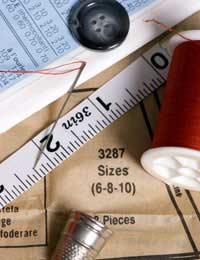Keeping Records of Your Patterns and Fabrics

In any business, proper record keeping is of vital importance, but in fashion it's even more so as your records - your stored information and ideas - form the very core of your business. Dressmaking cannot be undertaken professionally without patterns, and it's important to store old sewing patterns for reference, no matter what clothing you've moved on to since.
You might wonder why old patterns matter. In fashion, you don't want to repeat yourself. Even when retro movements happen, the new versions of old clothes are distinctly updated. But old patterns can be useful for dealing with special requests when, say, a particular retailer has had a lot of success selling particular clothing of yours and wants more. And they can be useful because they're not just a record of garments, but of the individual parts of those garments. Just because you've made all the shirts of a particular type that you ever want to doesn't mean that you won't want to make a garment with the same style of shoulders at some point.
Storing Patterns
In order to best protect your dressmaking patterns it's a good idea to keep more than one copy of each, one on a computer and one on paper. Paper patterns can be vulnerable to physical damage and digital ones can be vulnerable to data damage, but it's unlikely that both these things will happen at once. To make sure your computer records are safe from theft by hackers, keep them on an external hard drive disconnected from your computer except for when you need to reference them. Make sure that you frequently empty your computer's cache memory to dispose of indirectly stored images.There is no right way to catalogue your designs. Most designers prefer to do it by season or by year, but some record collections all together whilst others like to organise it by type of garment. It's up to you to develop a system you're comfortable with, but make sure it's well indexed and that everybody in your company (who needs to access it at all) is using it in the same way.
Each stored pattern should be accompanied by notes describing the materials it was made from (including small items like trimming) and detailing any problems which were encountered during the manufacturing process. If possible, note how many of the finished garments sold and how long they took to do so. List the retailers who stocked those garments.
Keeping Fabric Samples
An important part of any fashion designer's sewing records is their fabric sample collection. This needs to be stored very carefully to protect samples from deterioration. The simplest way is to use a box folder with loose-leaf pages and staple each fabric sample to a separate page. Never use glue or tape, which can damage the fabric over the long term. Don't place fabric samples next to each other where dyes can be transferred between them. Code and cross-reference your fabric samples and your patterns.Keeping actual fabric samples, rather than just descriptions, is very important as it can be difficult to record all the details of a fabric precisely (the thickness of the weave, the tone and saturation of colour, the roughness of the texture, etc.), and often tiny details can affect the way a garment looks and hangs quite dramatically. What's more, it can be difficult, years later, to visualise a fabric properly based solely on a set of statistical data.
All of this may seem like a lot of trouble to go to when your fashion design business is new and you've already got so many things to get used to, but getting it right at the very start can make things much easier for you later on.
- Running Your Fashion Business Ethically
- What to Do if Your Supplier Lets you Down.
- Using Fashion Trade Shows to Source Products
- Utilising or Selling Leftover Fabric
- Seasonal Fashion: Preparing and Marketing Designs
- Selling Your Fashion Designs by Mail Order
- Having a Signature Fashion Print
- Sourcing Specialist Materials and Fabrics
- Sourcing Fabric for Your Fashion Design Business


Re: Predicting and Following Fashion Trends
I enjoyed this article on predicting and following fashion trends. It's amazing how the blog breaks down the…
Re: Selling Your Fashion Designs Online
Hi how can i sell my designs while being a student in the 10th grade
Re: Basic Equipment for Starting up a Fashion Business
I want to start small business as a student and also fashion designer, and I don't have much money for…
Re: Basic Equipment for Starting up a Fashion Business
I'm a fashion designer, I want to start a fashion school, I want to know the necessary requirements to…
Re: Basic Equipment for Starting up a Fashion Business
I am a fashion designer and I am working on having my own fashion brand,please what are the necessary…
Re: Basic Equipment for Starting up a Fashion Business
I am an up coming fashion designer,I want to start my personal clothing brand. Please what are the…
Re: Basic Equipment for Starting up a Fashion Business
What can 30,000 do for fashion designing business Why you need an additional tools
Re: Keeping Records of Your Patterns and Fabrics
Can anyone tell me the type of records to be kept as a garment maker?
Re: Selling Your Fashion Designs Online
Hi I'm not a professional designer, but I have doing many sketches of trending dresses. I'm wondering how can I sell them…
Re: Selling Your Fashion Designs Online
Hi there, I'm not a fashion designer too I just started my intermediate and I do have many designs of beautiful outfits I…